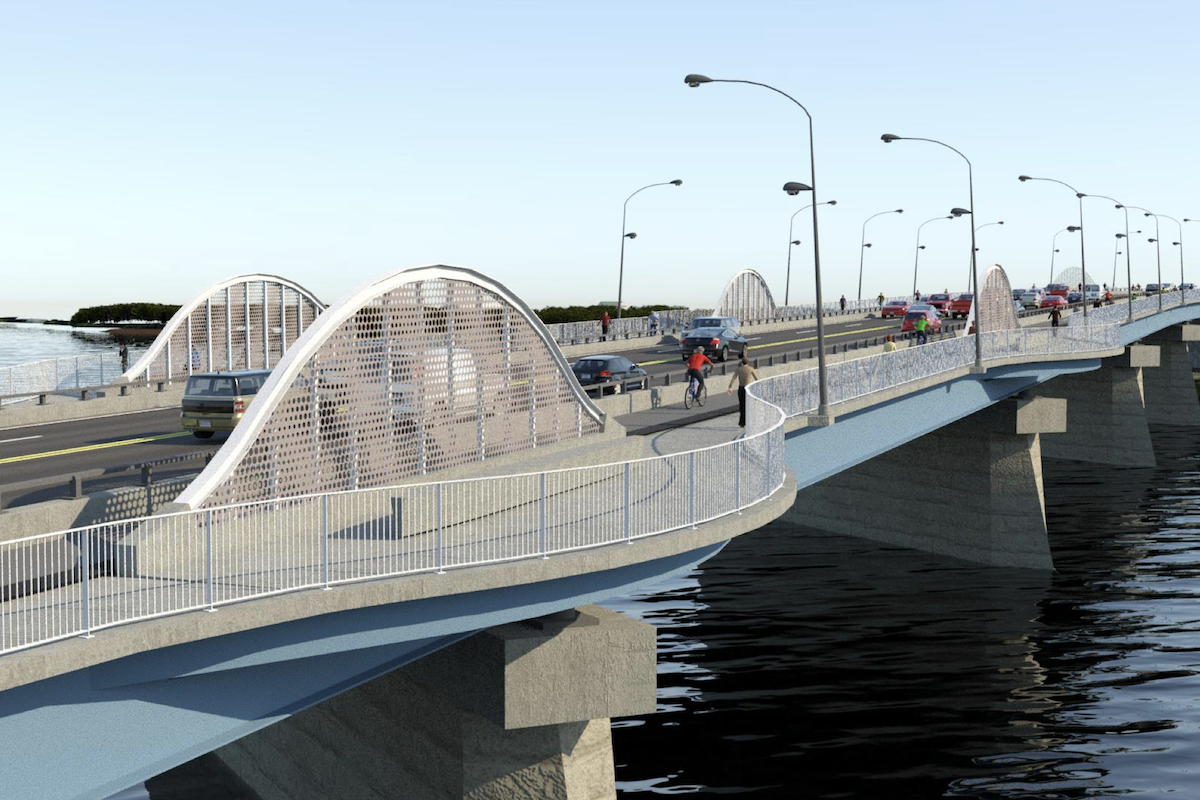The Interstate Highway System remains the workhorse of the U.S. transportation system: heavily traveled and providing the most important link in the nation’s supply chain, and the primary connection between and within urban communities. The importance of the Interstate Highway System and the reliable movement of goods it provides has been heightened during the response to the COVID-19 pandemic. But America’s Interstate highways are wearing out and showing signs of their advanced age, often heavily congested, and in need of significant reconstruction, modernization, and expansion.
In 2015, as part of the Fixing America’s Surface Transportation (FAST) Act, the U.S. Congress asked the Transportation Research Board (TRB), a division of the National Academy of Sciences, Engineering and Medicine, to conduct a study to determine actions needed to upgrade and restore the Interstate Highway System to fulfill its role of safely and efficiently meeting the nation’s future critical personal, commercial and military travel needs. In 2019, the TRB provided Congress with a report that found that the nation’s Interstates are heavily congested and aging, with large portions of the system in need of major reconstruction and modernization. The report found that addressing the needs of the Interstate Highway System will require more than a doubling of current investment to adequately improve the system’s condition, reliability and safety, and that the restoration of the nation’s Interstate Highway System should be based on strong federal leadership of a collaborative effort with the states.
TRIP’s Restoring the Interstate Highway System report provides the latest information on the Interstate system, including pavement conditions, bridge conditions, travel trends, traffic congestion levels, truck use, and traffic safety. It reviews the findings of the TRB Interstate report and concludes with recommended actions - based on the findings of the TRB report - to ensure that the system is able to meet the nation’s transportation needs.
- The Interstate Highway System has a persistent and growing backlog of physical and operational deficiencies as a result of age, heavy use and deferred reinvestment, and is in need of major reconstruction and modernization.
- Most roadway segments of the Interstate Highway System retain their original underlying foundations and need to be completely rebuilt from the subbase up.
- The repeated resurfacing of Interstate highways is not addressing the deterioration of roadway subbases. Repeated resurfacing – rather than addressing underlying foundational issues – provides diminishing returns as additional resurfacing results in increasingly shorter periods of pavement smoothness and is likely to result in higher lifecycle costs than periodic reconstruction.
- The modernization of the Interstate Highway System needs to include the following: reconstruction of the majority of Interstate highways and bridges, including their foundations; the upgrade of most interchanges to improve their function and safety; the addition of capacity along existing corridors, the construction of new routes and the conversion of some existing routes to Interstate standards; the modification of some urban segments to maintain connectivity while remediating economic and social disruption; and, further improvement of highway safety features.
- To address the physical and operational deficiencies identified in the TRB report, annual investment in the Interstate Highway System should be increased by approximately two-and-a-half times, from its current level of $23 billion in 2018 to $57 billion annually over the next 20 years.
- The restoration of the nation’s Interstate Highway System will require strong federal leadership and a robust federal-state partnership.
- The Interstate Highway System, which includes 2.6 percent of all roadway lane miles in the U.S., carries 26 percent of the nation’s vehicle travel.
- The 48,440-mile Interstate Highway System includes 10 transcontinental routes and highways varying in length from 18 miles to more than 3,000 miles.
- Since funding of the Interstate system was approved in 1956 to 2018, annual vehicle miles of travel (VMT) in the U.S. increased by 418 percent, from 626 billion miles driven, to approximately 3.2 trillion miles driven.
- From 1956 to 2018, the number of vehicles in the nation increased by 357 percent, from 65 million vehicles to 274 million vehicles. The nation’s population increased by 95 percent, from 168 million to 327 million during this time.
- In 1919, Lieutenant Dwight D. Eisenhower participated in the U.S. Army’s first transcontinental motor convoy, from Washington, D.C., to San Francisco, California. The trip took 62 days, largely due to inadequate roads and highways.
- In 1954, President Eisenhower appointed a committee to draft a proposal to fund a national system of Interstate Highways. The initial proposal, subsequently dismissed by Congress, called for financing a national Interstate system through bond financing.
- Nationwide construction of the Interstate Highway System began in 1956 following the approval of the Federal-Aid Highway Act of 1956. Some segments of urban and regional highways built prior to 1956 were later incorporated into the Interstate Highway System.
- The Federal-Aid Highway Act of 1956, signed into law by President Dwight Eisenhower on June 29, 1956, called for the construction of a 41,000-mile system of Interstate highways. The Act called for the Interstates to be paid for by taxes on motorists, such as the federal motor fuel tax, with the federal government paying 90 percent of the initial construction costs.
- The federal motor fuel tax was set at three cents-per-gallon in 1956 and is now 18.4 cents-per-gallon.
- Revenue collected from the 18.4 cents-per-gallon federal motor fuel tax and the 24.4 cents-per-gallon federal diesel fuel tax are the primary sources of funding for the federal Highway Trust Fund, which distributes funds to state and local governments for highway and bridge repairs as well as other surface transportation improvements, including public transit, pedestrian, and bicycling facilities.
- Pavements on 11 percent of Interstate highways are in poor or mediocre condition, with 3 percent rated in poor condition and 8 percent rated in mediocre condition. Another 9 percent of Interstate pavements are in fair condition and the remaining 79 percent are in good condition.
- An analysis of U.S. Department of Transportation’s National Bridge Inventory data indicates that more than one quarter – 27 percent – of Interstate bridges (15,709 of 57,741) are in need of repair or replacement.
- Three percent of the nation’s Interstate bridges are rated in poor/structurally deficient condition, and 56 percent are rated in fair condition. A bridge is rated in poor/structurally deficient condition if there is significant deterioration of the bridge deck, supports, or other major components.
- The intended lifespan of many of the nation’s Interstate bridges at the time of their construction is 50 years, though newer bridges are often built with longer-lasting materials and techniques that allow for a longer intended lifespan. Older bridges often need significant repairs or rehabilitation or may need to be replaced to continue to provide adequate service.
- The average age of the nation’s Interstate bridges is 45 years. Fifty-four percent of the nation’s Interstate bridges are at least 50 years old. The chart below shows states with the largest share of Interstate bridges 50 years old or older.
- The Interstate Highway System provides a network of highways with a variety of safety designs that greatly reduce the likelihood of serious crashes. Travel on the nation’s Interstate highways is more than twice as safe as travel on all other roadways.
- The Interstate Highway System, which carried 26 percent of the nation’s travel in 2018, accounted for only 13 percent of the nation’s traffic fatalities as a result of superior safety features.
- The features that make Interstates safer than other roads include a separation from other roads and rail lines, a minimum of four-lanes, gentler curves, paved shoulders, median barriers, and rumble strips to warn drivers when they are leaving the roadway.
- Travel on the nation’s Interstate highways is more than twice as safe as travel on all other roadways. The fatality rate per 100 million vehicle miles of travel on the Interstate system in 2018 was 0.58, compared to 1.32 on non-Interstate routes.
- The following chart details states with the highest traffic fatality rates in 2018 on their Interstate highways and the fatality rate on all other roads in those states.
- The Interstate system carried 53 percent of all large commercial truck travel in the U.S. in 2018.
- Travel by combination trucks on the Interstate Highway System increased 45 percent from 2000 to 2018, nearly double the 25 percent rate of growth for all vehicle travel during the same period.
- Travel by combination trucks, which are the large trucks that carry the majority of freight shipped in the U.S., accounted for 11 percent of all vehicle miles of travel on the Interstate Highway System in 2018.
- Every year, $16.8 trillion in goods are shipped from sites in the U.S.
- Seventy-two percent of the goods shipped annually from sites in the U.S. are carried by trucks and another 14 percent are carried by courier services, which use trucks for part of the deliveries.
- The completion of the vast majority of the Interstate system by the 1980s, and the deregulation of the U.S. trucking industry, resulted in a significant improvement in the competitiveness of U.S. business. The cost of moving freight, as measured by U.S. business logistics costs, dropped from 16 percent of U.S. Gross Domestic Product (GDP) in 1980 to 8 percent in 2018.
- The TRB report found that U.S. counties either on an Interstate highway or within 20 miles of an Interstate are anticipated to grow in population through 2060 at a rate approximately seven times greater than counties that are at least 20 miles from an Interstate highway (36 percent versus 5 percent).
- The Interstate Highway System has reduced travel times between destinations throughout the U.S. The improved mobility provided by the Interstate Highway System has given Americans greater choices about where they live, work, shop and spend their leisure time.
- The current backlog of needed improvements on the nation’s Interstate Highway System is estimated by the USDOT to be $123 billion.
- The backlog on the nation’s Interstate Highway System includes $54 billion needed to improve pavement conditions, $37 billion to improve bridges and $33 billion for needed system expansion and enhancement.
- The ability of states to invest in Interstate highway repairs and improvements may be hampered by the tremendous decrease in vehicle travel that has occurred due to the COVID-19 pandemic, which the American Association of State Highway and Transportation Officials estimates will reduce state transportation revenues by at least 30 percent – approximately $50 billion - over the next 18 months.
- The primary source of revenue for the Interstate Highway System is the federal surface transportation program, which expires on September 30, 2020. The program does not have a long-term and sustainable revenue source.
- Signed into law in December 2015, the Fixing America’s Surface Transportation (FAST Act), provides modest increases in federal highway and transit spending, allows states greater long-term funding certainty and streamlines the federal project approval process.
- Revenue collected from the 18.4 cents-per-gallon federal motor fuel tax and the 24.4 cents-per-gallon federal diesel fuel tax are the primary sources of funding for the federal Highway Trust Fund, which distributes funds to state and local governments for highway and bridge repairs and other surface transportation improvements, including public transit, pedestrian and bicycling facilities.
The following recommendations, based on the findings and recommendations of the TRB Interstate report, provide a roadmap for the restoration of the Interstate Highway System:
- Reconstruct the nation’s Interstate Highway System, including pavements, bridges and interchanges
- Improve safety features on Interstate highways
- Right-size the Interstate Highway System by:
- Upgrading some existing roadways to Interstate standard
- Adding needed additional highway capacity on existing routes to maintain and improve mobility
- Adding additional corridors to accommodate demographic and economic growth
- Modifying some urban segments to maintain connectivity while remediating economic and social disruption

| Your local Wirtgen America dealer |
|---|
| United Construction & Forestry |
| WI Clark |













































































